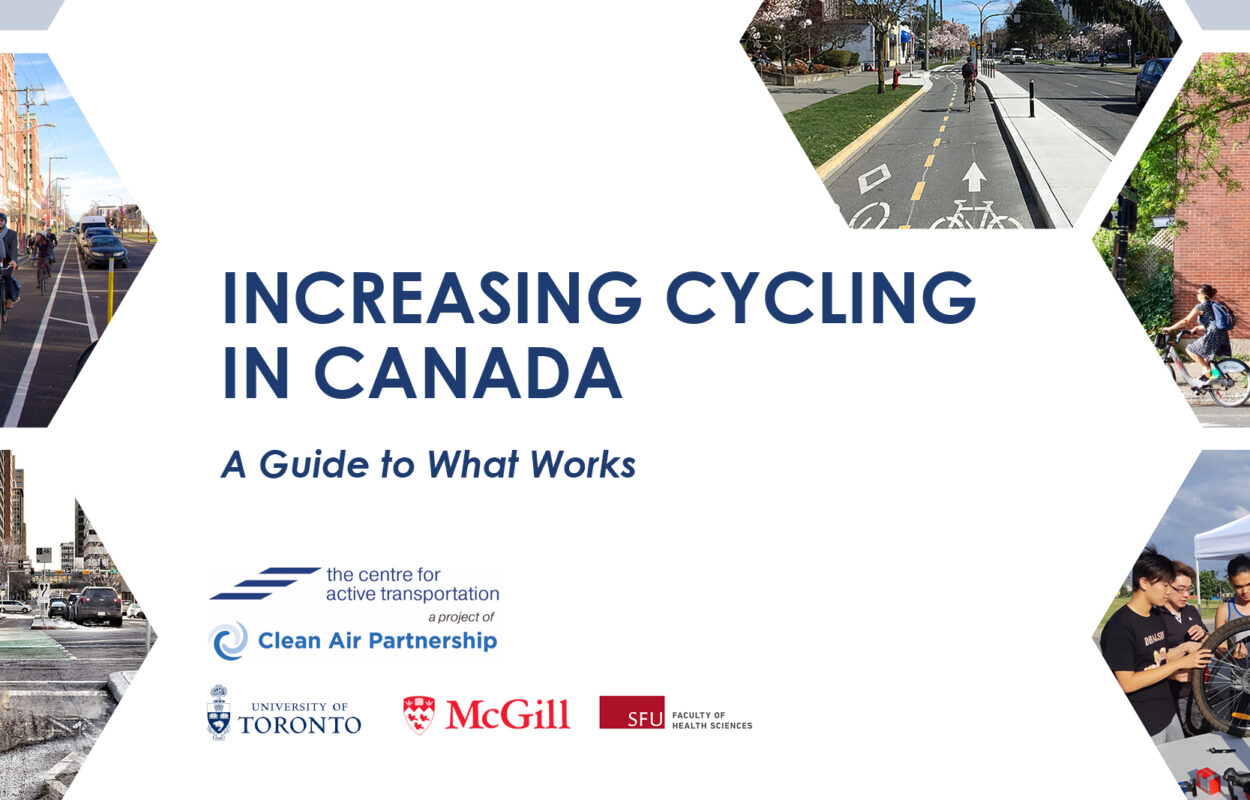
For immediate release: September 25, 2019
Toronto, ON – Communities can take tangible action to grow cycling as a viable transportation option for Canadians. That’s the message of a new guide released today by The Centre for Active Transportation (TCAT) at Clean Air Partnership, in collaboration with researchers from the University of Toronto, McGill University and Simon Fraser University.
Increasing Cycling in Canada: A Guide to What Works, offers municipalities ten recommended actions to grow cycling in their communities. The authors drew on five years of research to develop the list. As part of their research, they identified places in Canada where cycling has increased significantly and then analyzed data sets and conducted interviews to determine why.
While the guide points to high quality, protected cycling infrastructure as a key contributor to cycling growth, it also makes recommendations covering programming and engagement, culture, policy and addressing hills and inclement weather. For example, in suburban and smaller communities where cycling growth has been slower, the guide recommends using data to identify neighbourhoods with high cycling potential and developing partnerships with local community organizations to build cycling culture. The guide’s recommendations all include examples of how these actions have been implemented in communities across Canada.
“What’s so unique about this guide is that it integrates programming and infrastructure,” says Dr. Beth Savan, Principal Investigator on the project. “We know that good quality infrastructure is crucial, but there are many actions municipalities can take to remove barriers, spark cycling adoption, and sustain cycling behaviour, particularly in places where cycling rates are currently low.”
“Over the past two decades, we’ve seen tremendous growth in cycling in many places across Canada,” says TCAT Director Nancy Smith Lea. “Our goal with this guide is to share what we learned from these successes so that other communities can move forward more expeditiously and effectively to grow cycling and capture its many diverse benefits.”
Quick Facts:
- Identify cycling potential: More short trips, more trips per day, and fewer cars per person are all associated with more cycling. Map these factors to find places with the best potential for increasing cycling.
- Make it safe: Having safe routes to ride is crucial. Canada’s top neighbourhoods for cycling in 2016 had almost four times more cycling infrastructure than other neighbourhoods.
- Pair up projects and programs: Cycling infrastructure and programming have the greatest impact when they act synergistically. Amplify the impact of new facilities by pairing them with cycling-friendly policies and targeted, community-based campaigns.
- Address weather and hills: Snowy weather and hills can be challenging for people on bike. Yet Montreal has seen cycling increase by 170% over the past 20 years. Prioritize key cycling routes for snow-clearing and provide help getting up hills.
- This research was funded by the Social Sciences and Humanities Research Council (SSHRC) and the Metcalf Foundation.
More Information:
- Explore Where Cycling is Increasing and How Can You Increase Cycling, or download the full report: Increasing Cycling in Canada: A Guide to What Works.
- The team gathered costing information for over 40 cycling facilities and programming initiatives that have recently been implemented in communities across Canada. A number of examples are included in the guide, while the rest can be found in a separate catalogue: Costing of Bicycle Infrastructure and Programs in Canada.
- Download a PDF of the Increasing Cycling in Canada Press Release.
About TCAT:
The Centre for Active Transportation (TCAT), a project of Clean Air Partnership (CAP), advances knowledge and evidence to build support for safe and inclusive streets for walking and cycling. We believe that active transportation plays a critical role in creating environmentally and economically sustainable cities.
